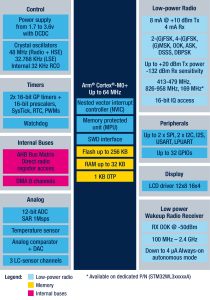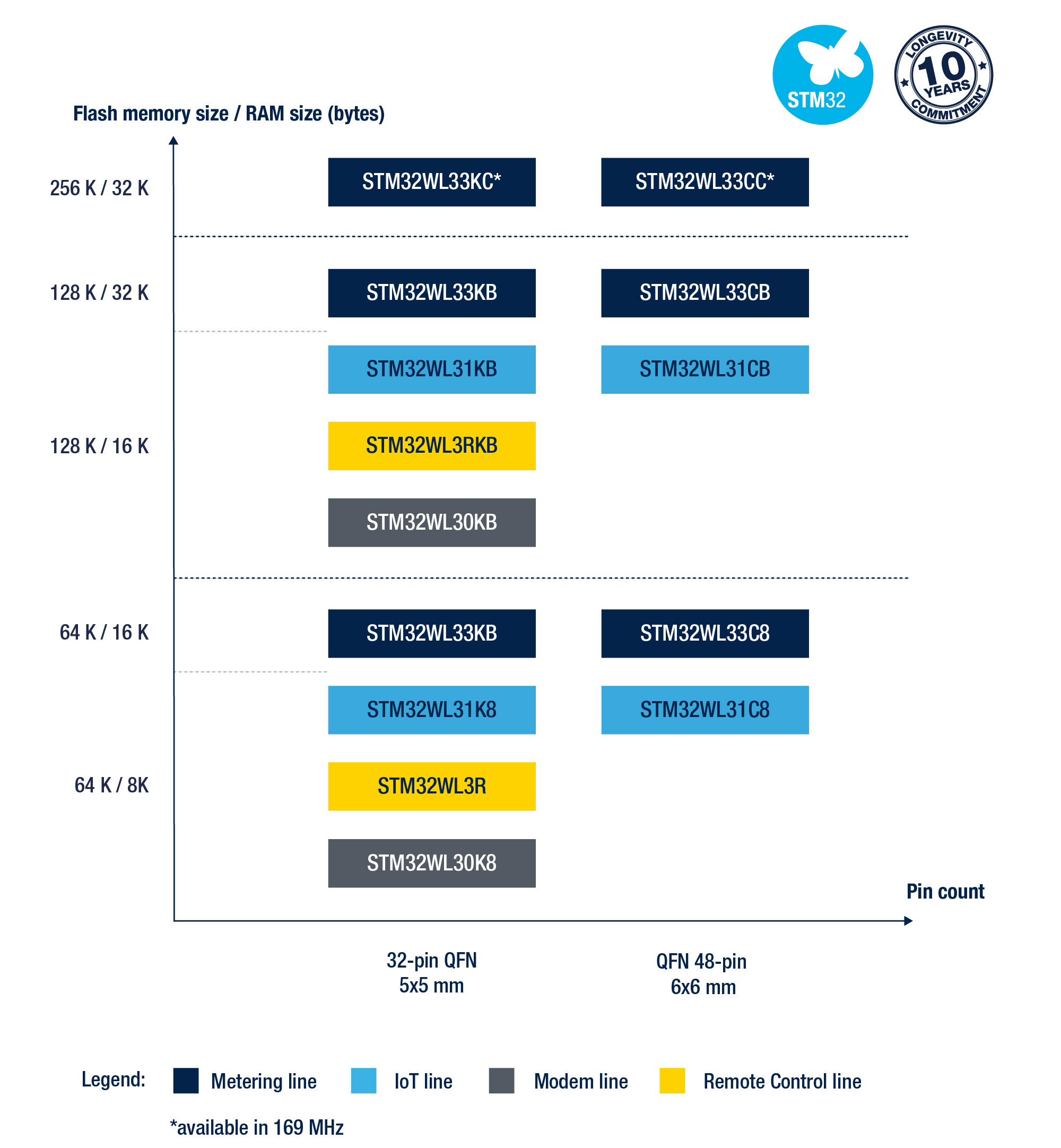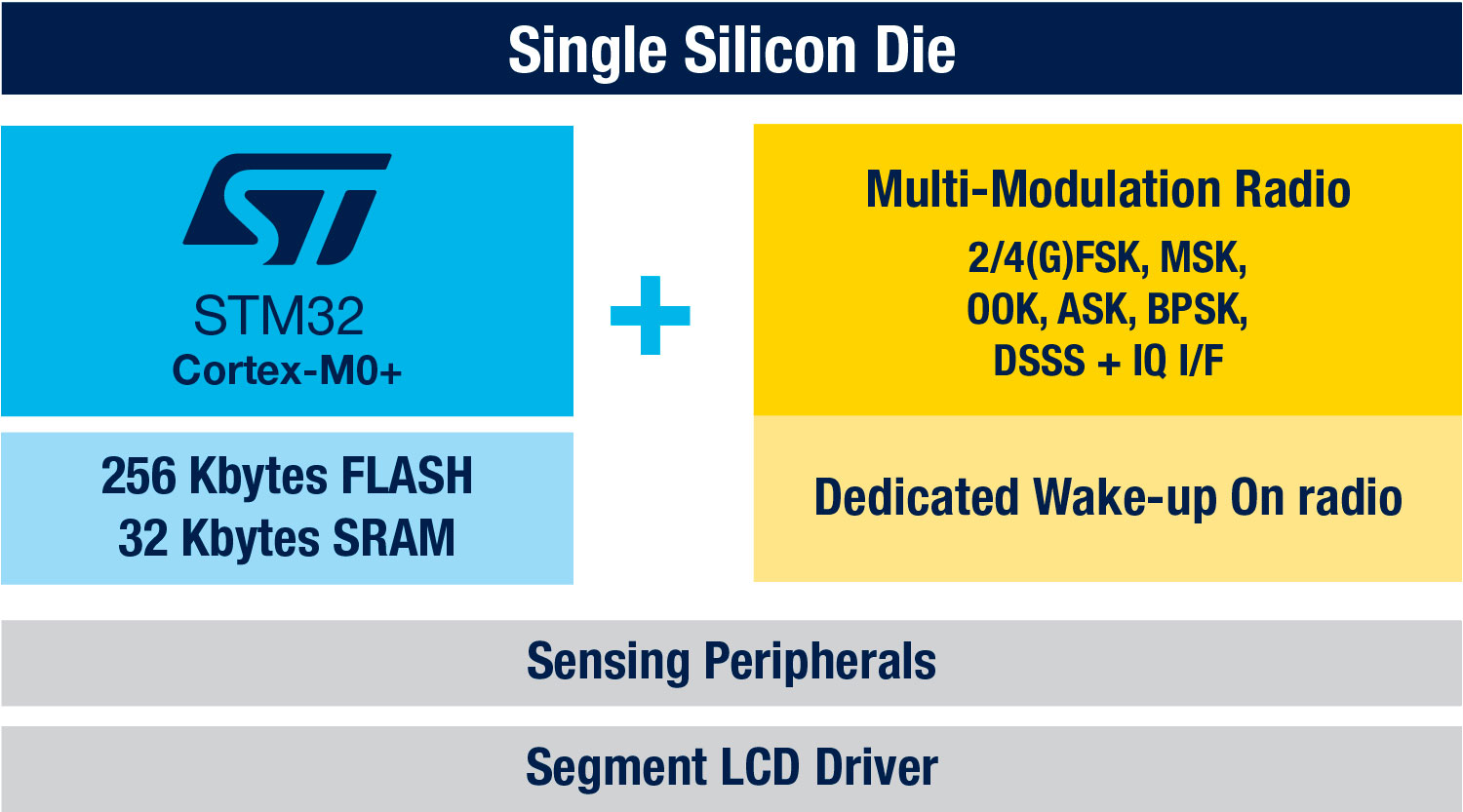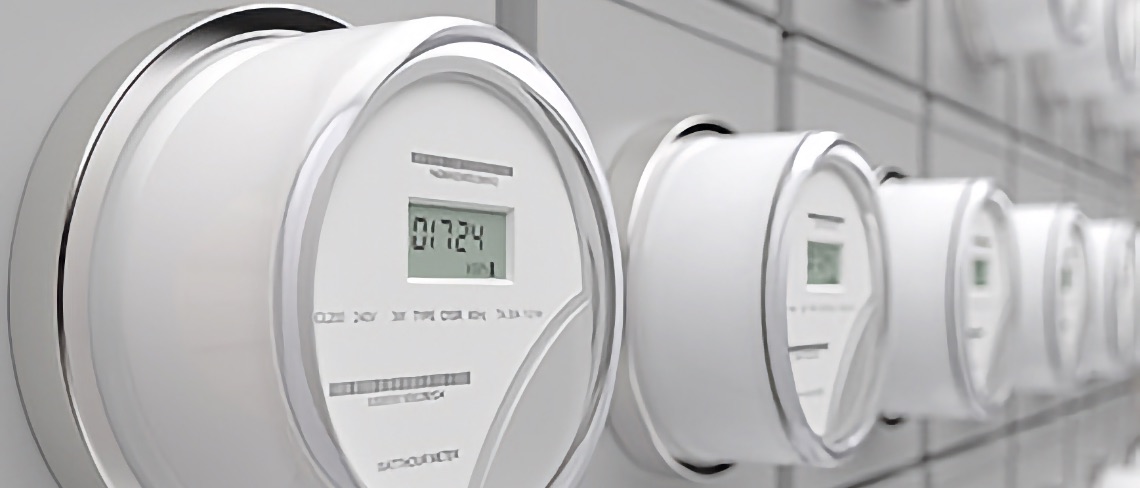ST is announcing the STM32WL3R, the first STM32WL3 designed with remote-control applications in mind. It comes with more wake-up pins, even lower power modes, and support for a new frequency band used for this use case. The STM32WL3 is a sub-GHz wireless microcontroller with an ultra-low-power wakeup receiver and an updated S2-LP transceiver featuring additional modulation support. Over time, ST has added more devices to this family to better serve engineers working on a wide range of applications. This is the latest innovation to make sub-gigahertz applications more accessible.
Table of Contents
What’s new?
STM32WL3R
The STM32WL3R shares the same DNA as the STM32WL3, but includes six wake-up pins, instead of just one. The reason is simple. Remote control applications use many buttons, and developers need many of them to wake the MCU from sleep. By offering more wake-up pins, engineers gain much greater flexibility and can use more buttons for that purpose. Additionally, the shared architecture between the STM32WL3 and the STM32WL3R means engineers can reuse the PCB layout they designed for the former while enjoying the latter’s new low-power modes. Indeed, the STM32WL3R comes with new profiles with RAM retention that disable more hardware units for greater power savings.
At its core, the STM32WL3R uses a similar ultra-low-power radio. It still consumes only 10 mA at 10 dB, making it one of the most efficient sub-gigahertz radios in a wireless microcontroller. Additionally, it is the first radio on an STM32WL3 to support the 315 MHz frequency band for remote control applications. That’s on top of the other bands for Europe, America, and Asia already offered by the STM32WL3. Engineers can thus design for many regions and products while qualifying only one device. The STM32WL3R will be broadly available, early next year, in two versions: one with a transmitter only, for remote controls that only send a signal, and one with a transmitter and a receiver.
From STM32WL5 to STM32WL3: Finding a new balance of power
The STM32WL entered volume production at the end of 2023. We worked with select partners and customers on the Nucleo platforms before releasing them to the public, resulting in unique designs. For instance, Lierda announced its WB18 module. Based on the STM32WL3, the WB18 simplifies data transfer within a network by using a serial interface for packet transmission, thus enabling point-to-point and point-to-multiple communication. The company also provides an LCD driver port for more interactive UIs. Similarly, SilentSmart launched its WS8561xLS, an STM32WL33 UART module targeting smart cities, smart homes, and niche applications like healthcare and industrial settings.
How did it start?
Launched in 2020, the STM32WL series showcased the first microcontroller with an embedded LoRa® transceiver, the STM32WLEx. Both the radio and the application ran on a Cortex-M4, enabling newcomers to enjoy a processor with enough computational throughput for a lot of applications while keeping costs down. Strengthened by the positive industry reception to this new type of device, ST released the STM32WL5 a year later. The MCU distinguished itself thanks to a dual-core architecture that added a Cortex-M0+ to run the wireless stack on top of the Cortex-M4 of the earlier model. The device targets more high-end applications that require the security and isolation provided by the Cortex-M0+.
How is it going?
The STM32WL3 expanded the existing portfolio by targeting a new type of application: low-power and cost-sensitive systems. It features a Cortex-M0+ for the radio and the application, offering significantly lower power consumption: only 47 µA/MHz in dynamic consumption for the STM32WL3, versus 72 µA/MHz for the STM32WLE. The MCU also has up to 256 kB of flash and up to 32 kB of RAM. Hence, when companies build a smart smoke detector or an asset tracker that uses a coin battery for years, they can benefit from the MCU’s energy efficiency while still having the resources to run an application comfortably.

Avid readers will remember that we announced the OEM launch of the STM32WL3 in 2023. Since then, our teams have worked to create an ecosystem that allow engineers to move from proof-of-concept to a final product rapidly. For instance, the STM32CubeWL3 firmware package comes with a hardware abstraction layer, middleware, and RTOS necessary to start writing applications in minutes. There are even application examples to get started faster. Moreover, tools like STM32CubeMX, STM32CubeProgrammer, STM32CubeMonitor, and STM32CubeIDE will receive updates over the coming months to support the new package and device, thus truly integrating the STM32WL3 into the STM32 ecosystem.
STM32WL31x and STM32WL30x for asset tracking and cost-effective IoT
Earlier in 2025, ST launched the STM32WL31x and STM32WL30x, which tailored versions of the STM32WL33x for designers who wish to focus on specific features while lowering their bill of materials. For instance, we built the STM32WL31x with IoT sensors and IoT asset tracking in mind, which meant removing the LCD driver, the DAC and comparator, and the LC sensor controller, and keeping the most critical features for IoT applications, such as ADC, I2C, UART, and SPI interfaces.
Since the LC sensor controller is primarily for smart water metering applications, having it on a design that monitors several sensors is superfluous. The STM32WL31x offers up to 128 KB of flash and is available in QFN32 and QFN48 packages, which is essential when space is a constraint. The main radio is also the same as the STM32WL33x line, which reduces BoM cost without compromising energy efficiency and RF performance. This can significantly increase the overall battery life and connectivity range of IoT systems.
As for the STM32WL30x, it serves those looking for a co-processor. In many applications, engineers have a primary host MCU with all the bells and whistles needed for their system and don’t want the wireless stack on the main MCU, which means they can’t get a radio by itself. In this instance, a simple co-processor focusing on UART and SPI interfaces to communicate with the host MCU is the best. Hence, we omitted I2C or ADC interfaces, besides what the STM32WL31x already shaved off, to improve costs further. Put simply, the STM32WL30x is the most cost-effective way to enjoy the ST sub-GHz optimized radio and the STM32Cube environment.
From S2-LP to 2 new radios: Reaching new optimization levels
Why have a wake-up radio?
Another innovation unique to the STM32WL3 is the presence of two radios, one dedicated to a low-power wake-up function. Designed for proximity detection, it only supports OOK modulation, has a continuous RX mode, and is compatible with a wide frequency band from 100 MHz to 2.4 GHz. As a result, it consumes a meager 4.2 µA, an order of magnitude lower than a traditional radio. For comparison, the regular sub-GHz module of the STM32WL3 needs 5.6 mA in RX mode, which is already considered an efficient device by today’s standards.
Developers can use a traditional gateway to take advantage of the wake-up radio. Many may already have one that’s supported since the wake-up radio covers a wide range of frequencies. When the STM32WL3 comes near the gateway, it receives a packet and triggers a wake-up function to turn the regular radio and MCU on. The wake-up radio is sensitive enough (-53 dBm) to have a range of tens of meters (more than 32 feet), which means it can operate in various settings, from warehouses to smart factories or smart cities. The output power also got a boost to reach up to +20 dBm in transmission, whereas the S2-LP reached +16 dBm.
Why improve on the S2-LP?

The regular radio in the STM32WL3 is an updated version of the S2-LP with support for (G)MSK, DBPSK, and DSSS on top of the traditional 4-(G)FSK, 2-(G)FSK, OOK, and ASK. Consequently, the device natively supports 802.15.4g and is compatible with 6LoWPAN, MBus, Sigfox, WiSUN, and KNX protocols. Moreover, thanks to its new capabilities, the STM32WL3 is Mioty-capable, thus further expanding the new device’s reach in Europe. The radio of the STM32WL3 is also more power efficient in RX (5.6 mA vs. 7 mA for the S2-LP) and TX (8 mA vs 10 mA for the S2-LP). It also provides greater output power at +20 dBm (+16 dBm for the S2-LP).
ST is also thrilled to announce that its partners are already working on wireless stacks to ensure developers can rapidly support these protocols. STACKFORCE already has a WMBUS/OMS stack ready to use for end nodes and gateways, and Fraunhofer IIS will have a Mioty stack ready by the first half of 2025. Additionally, a Wi-SUN PHY layer is also ready for certification, which should significantly reduce the time to market.
From flow metering to asset tracking: Solving new problems one app at a time
How to focus on smart metering?

To make the STM32WL3 even more meaningful, ST engineers added features targeting some of the most popular use cases. For instance, the new device includes an LC Sensor Controller (LCSC), which detects mechanical-wheel fluid metering. As the wheel of a metering system tracks the amount of water consumed, a circuit inside the STM32WL3 increments a value inside a register after each wheel revolution. Consequently, the MCU records the wheel’s rotations without waking the Cortex-M0+ for more significant energy savings since it only requires between 2 µA and 4 µA. After the value stored in the register reaches a threshold or after a certain period, the system wakes the CPU, which records the value in memory.
Furthermore, ST is releasing a version of the STM32WL3 supporting a wireless band of 169 MHz. Ending with “A”, the STM32WL3 part number will thus be compatible with Wize, a European standard for remote areas that would benefit from long-range communication. The standard aims to popularize smart city applications, water metering, energy tracking, waste management, and more. ST is using the launch of the new STM32WL3 to contribute to this new interconnectivity effort at a very large scale.
How to optimize for worldwide asset tracking?

Another feature tailored for the most common applications is the presence of two power amplifiers for the sub-GHz radio. Indeed, since asset tracking is one of the widespread use cases for the STM32WL3, the device must be able to adapt to different regional wireless standards automatically. For instance, the European Union and Japan mandate using +14 dBm of output power, whereas North America goes up to +20 dBm. By having two power amplifiers, the STM32WL3 can automatically switch from one to the other. Engineers don’t have to qualify a different product for each region and can vastly simplify developments, which more than makes up for the cost associated with the presence of another amplifier.
How to streamline development?
Regarding developments, the STM32WL3 is symbolic because it brings the S2-LP DNA to the STM32 ecosystem. ST will continue to offer the S2-LP transceiver and support the existing software stacks to help teams that need a more modular approach. Put simply, many are still eyeing an S2-LP alongside an STM32 MCU for scalability or flexibility reasons. However, by the end of next year, the ability to use the STM32WL3 with the STM32Cube ecosystem will make it familiar and practical. In all cases, our goal is to ensure developers can write proofs-of-concept and demo applications much faster as the initialization process benefits from existing UIs, and example codes are often just a few clicks away.
We also launched tools to optimize engineers’ workflows on our newest device. One of them is WiSE-RadioExplorer, a wide survey explorer with a graphical user interface to tweak the sub-GHz radio more easily and experiment with its capabilities. The other is WiSE-RadioCodeGen, which builds flowcharts that map actions the radio will take under certain conditions, thanks to a sequencer driver, thus giving developers vastly more granular control over the STM32WL3’s behavior.
The best way to get started is to grab one of the two Nucleo boards featuring the new device, the NUCLEO-WL3CC1 (high band) or NUCLEO-WL33CC2 (low band). They will help engineers run demo applications, test the new software utilities, and even provide layout inspiration since their schematics and bills of materials are free. ST is also launching MLPF-WL-01D3/02D3/04D3, integrated power devices containing filters compatible with the STM32WL3, so integrators don’t even have to worry about what components to select or how to tune them, making the overall design phase even more intuitive. We are also providing a pre-certified and tuned reference design, the STDES-WL3xxxx.



